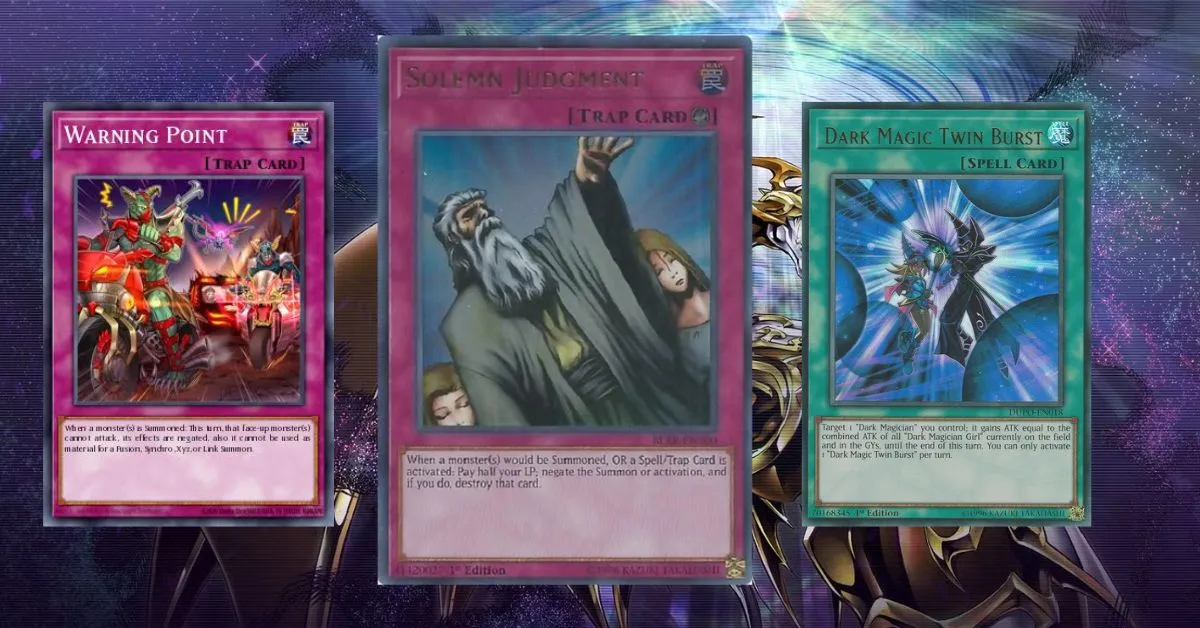The Solemn cards have long been iconic staples in the Yu-Gi-Oh! universe, evoking both excitement and strategic debate among duelists. From the legendary Solemn Judgment to heavy hitters like Solemn Strike and Solemn Warning, these trap cards have defined countless strategies over the years. But as the game marches forward into 2034, the pressing question arises: are these once-essential cards still relevant, or have they succumbed to the inevitable creep of time and power?
In a world where the Yu-Gi-Oh! metagame is evolving at breakneck speed, how do the Solemn cards hold up against modern threats? Do they still serve as pillars of negation, or are they relics of a bygone era? This article delves deep into the evolution, strengths, and shortcomings of the Solemn series, offering insights into whether they remain viable tools for today’s players or have transitioned into niche roles. Examining the metagame’s trajectory, we aim to uncover whether Solemn cards are a boom or bust in this fast-paced environment.
The Evolution of Solemn Cards
In the early days of Yu-Gi-Oh!, Solemn cards were revered as kings of negation. With its ability to negate virtually anything, Solemn Judgment quickly became a staple in many decks. Despite the steep cost of paying half one’s life points, its versatility made it a go-to card for competitive players. Over time, other options joined the fray:
- Solemn Warning: Aimed at negating summon effects at the cost of 2000 life points, it became a powerhouse in controlling special summons.
- Solemn Strike: Introduced as a counter to monster effects, it offered a cheaper alternative with a cost of 1500 life points.
These cards complemented various control strategies and offered players reliable tools to neutralize threats. However, as the game evolved, so did the challenges facing these legendary cards.
The Rise of Alternatives
With the introduction of hand traps like Ash Blossom & Joyous Spring and Infinite Impermanence, the Solemn cards began to face stiff competition. Hand traps brought immediate, chainable disruption without requiring any setup—a stark contrast to Solemn cards that needed to be set for a turn.
Additionally, archetype-specific negation tools started dominating the meta. Cards like Herald of Orange Light, Spright Red, and Baronne de Fleur offered similar functionality while synergizing better with their respective strategies. These developments pushed Solemn cards out of the limelight, even as their core utility remained intact.
The Modern Meta in 2034
The Yu-Gi-Oh! meta of 2034 is a high-speed battlefield. Archetypes now rely heavily on:
- One-turn setups: Decks that can establish formidable boards packed with negations and disruptions in a single turn.
- Multi-dimensional combos: Utilizing link monsters, XYZ summons, and fusions to create overwhelming board presence.
In this environment, traditional trap cards have struggled to keep up. The fast pace of the game leaves little room for cards that require setting. Many players prefer instant-speed cards that work from the hand or on the fly.
Increased Reliance on Hand Traps
Hand traps have redefined the way players handle threats. Cards like:
- Effect Veiler: Negates monster effects during the opponent’s turn.
- Nibiru, the Primal Being: Punishes opponents who summon excessively in a turn.
- Ghost Ogre & Snow Rabbit: Removes key cards from the field.
These tools bypass the field entirely, making traditional traps like Solemn Judgment seem outdated by comparison. In a meta defined by speed, players often prioritize quick, cost-free options.
Why Solemn Cards Still Shine
Despite the challenges, Solemn cards have enduring qualities that keep them relevant in certain contexts. Their ability to negate pivotal plays outright makes them valuable in the right hands. Here’s why they still matter:
Unmatched Flexibility
- Solemn Judgment can negate almost anything: monster summons, spell activations, or trap effects. This unmatched flexibility makes it a clutch card in moments where a single negation can change the game.
Precision in Control Strategies
Control decks often thrive by protecting a small number of key cards. Solemn cards excel here by stopping threats that could dismantle a carefully crafted board. For instance:
- Solemn Strike is a reliable counter to powerful monster effects.
- Solemn Warning prevents game-ending summons.
Splashable Utility
Unlike archetype-specific negations, Solemn cards can be used in any deck. This versatility ensures they remain viable for players who need general-purpose answers to the meta’s diverse threats.
The Downsides in Today’s Game
While the Solemn series retains its strengths, it also has significant drawbacks that make it less appealing in 2034’s meta:
Slower Speed
The biggest weakness of Solemn cards is their reliance on being set before activation. In a format where One-Turn Kills (OTKs) are common, surviving a turn to activate these cards can be difficult. Modern negations like Infinite Impermanence or Ash Blossom have a clear edge in terms of immediacy.
Steep Life Point Costs
Life point costs were manageable in earlier formats but now feel risky. Losing half your life points or even 1500 points for a single negation can leave players vulnerable. With games often ending within a few turns, these costs can backfire.
Overshadowed by Modern Tools
Today’s game offers cost-free negations that integrate seamlessly into combos. Cards like Borreload Savage Dragon and Baronne de Fleur provide similar effects while doubling as offensive threats. This dual functionality makes them more appealing than Solemn traps, which are purely defensive.
Comparing Solemn Cards to Modern Alternatives
In 2034, the Solemn series competes with a host of modern alternatives:
Hand Traps
Hand traps have become the backbone of many strategies. For instance:
- Ash Blossom & Joyous Spring negates critical search effects.
- Infinite Impermanence not only negates effects but can also disable a column.
These cards are faster, free, and don’t require setup, making them preferable in many decks.
Archetype-Specific Disruption
Modern archetypes are often designed with built-in negation tools that synergize perfectly with their strategies. Examples include:
- Spright Red: Negates monster effects while fitting seamlessly into Spright combos.
- Kashtira Fenrir: Disrupts opponents while doubling as a strong attacker.
These cards outshine solemn traps in speed and synergy, reducing the latter’s prominence.
The Player Perspective
The Yu-Gi-Oh! community is divided on the relevance of solemn cards. Here’s a breakdown:
Competitive Players
- Many competitive players avoid Solemn cards, citing their slow activation and life point costs as liabilities.
- Modern decks often prioritize synergy, making archetype-specific or combo-based negations more appealing.
Casual and Control Players
- In casual games, solemn cards still shine. Their simple yet powerful effects appeal to players who enjoy calculated decision-making.
- Control decks that rely on precise disruption often include these cards as key tools for maintaining board presence.
The Final Verdict
So, are Solemn cards still good in 2034? The answer lies in the context:
- In fast-paced metas: Solemn cards struggle to keep up with the speed and efficiency of modern tools.
- In slower, control-based formats: They remain valuable, offering precise and versatile negations that can turn the tide of battle.
While Solemn cards are no longer the universal staples they once were, they’ve found a niche as reliable tools for players who value strategy and precision.
Conclusion
The Solemn cards have undoubtedly seen better days, but they retain a unique charm in the world of Yu-Gi-Oh! Whether they’re worth running depends on the player’s deck and strategy. In 2034, they may not dominate the meta, but they’re far from irrelevant. For those willing to wield them wisely, Solemn cards offer a mix of power, precision, and nostalgia that few others can match.
FAQs:
Are Solemn cards still relevant in competitive play?
Solemn cards can be relevant in control-heavy formats, but they’re less common in the fast-paced meta of 2034.
Which Solemn card is the best for modern gameplay?
Solemn Strike is often considered the most viable due to its lower life point cost and ability to counter monster effects effectively.
Why do some players avoid using Solemn cards?
The reliance on setting them and the steep life point costs make them less appealing compared to faster, cost-free alternatives.
Can Solemn cards counter hand traps?
Solemn Judgment can negate hand traps, but it requires precise timing and a significant life point investment.
Are there better alternatives to Solemn cards in 2034?
Yes, hand traps like Ash Blossom and archetype-specific negation tools often provide faster and more efficient disruption.











